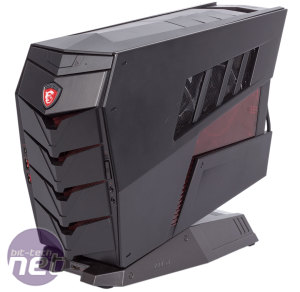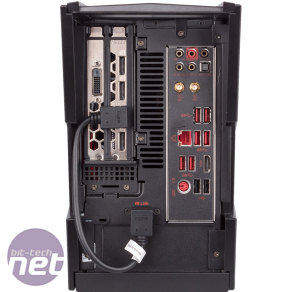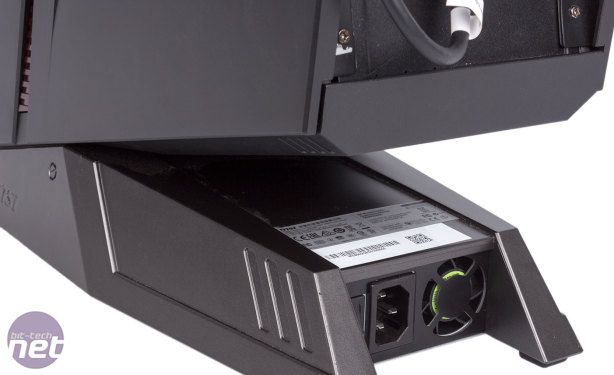
Performance Analysis
With a Core i7-6700K and GTX 1080 in tow, performance in games was always going to be excellent and the Aegis X doesn't disappoint. The system will handle 1440p with ease, although 4K in some games with maximum settings will still prove a bit too much. Nonetheless, if you can live with high rather than ultra settings, it would make a good partner for 4K gaming.In PCMark 8, the Video Editing score is good but a little lower than other Core i7-6700K systems, probably as a result of the Aegis X's lower than usual memory speed and modest overclock – 4.5GHz is the norm, rather than the 4.2GHz here. Nonetheless, it keeps pace better in the Photo Editing workload.
The mutli-threaded rendering workloads, Terragen 3 and Cinebench R15, output solid results but again the Aegis X is trumped by those PCs with CPUs that either run faster or have more cores (i.e. X99 systems). This isn't a major issue since the focus of this PC is clearly gaming.
The Raid 0 NVMe M.2 array works wonders, at least in synthetic tests like CrystalDiskMark – it sets a new record by some distance in the read test with speeds in excess of 3,000MB/sec, and the write speed is over 1,000MB/sec too. That said, while it's very fast in the PCMark 8 storage traces, it's not the absolute best, suggesting that real-world benefits of such speed may be harder to find.
We tested both at stock speeds and with the OC Genie button enabled. This made zero difference to games, which were evidently GPU-limited. The PCMark 8 Photo Editing workload did see a jump up – this is a workload where the CPU is required in bursts, so in the default mode it's constantly switching between faster and slower states. With the 4.2GHz frequency locked in, however, it's able to achieve one of the best scores we've seen (probably aided by the speedy storage too). The rendering benchmarks improve but only moderately and it's a similar story with the storage benchmarks. In short, the OC Genie button is neat in the way it simplifies overclocking, but the impact is pretty limited in most circumstances.
Idle power consumption is low with or without OC Genie at sub-60W. Under full load, the system peaked at 420W, so the 600W PSU should cope no matter what. Under sustained load, the CPU peaked at 85°C, demonstrating that the all-in-one cooler can cope but is being pushed quite hard. The GPU, meanwhile, hit 73°C, with the rock solid boost speed of 1,885MHz indicating that it wasn't being thermally throttled.
A real sticking point with this system, sadly, is noise. The prime culprit is the PSU, with the tiny 40mm fan being clearly audible and honestly quite annoying even when the system is doing nothing. The front fan and CPU cooler fan are very quiet when idle and the GPU fans switch off completely, so this is a real shame. Under load, things get worse – the CPU fan becomes another prominent source of noise and the GPU is audible too, although not overly so.
Conclusion
With most systems, we tend to assess them based on their cost versus what it would cost to build the same system yourself. With the custom design here, however, that's not really possible, although it should be noted that you can build yourself a similarly powerful system for hundreds of pounds less. The question is, then, what the custom design brings to the table and whether it's worth so much.One benefit is portability – the size coupled with the carrying handle makes this system about as easy as possible to transport. We also like the front-facing USB 3.1 Type-C connector (that doesn't rely on a cable looped around to a rear connection) and the HDMI port up front will definitely appeal to early VR adopters, and it's implemented neatly. The other aspect is simplicity – you get this system pre-built and ready to play games at awesome frame rates with no hassle. Overclocking is as easy as the press of a button, although its impact is really quite limited, and built-in customisable RGB lighting may also hold some appeal.
There are a number of downsides too, however. Firstly, regardless of whether you love or hate the aesthetics, the case quality just isn't high enough given the cost of the system, and the all plastic exterior disappointed us. The noise of the PSU is also hard to overlook, especially as this is a system that's likely to be sitting right next to you on your desk. We also weren't too impressed with how cluttered the desktop is with pre-installed apps, although novice users may enjoy some of what's offered.
If you're desperate for a small and portable desktop system to power VR headsets or maybe a 4K screen and want nothing to do with building it yourself, this could well be the system for you. The custom design will cost you a pretty penny, but if you're an early VR/4K adopter that's unlikely to be much of an issue. After all, you'll be playing VR with headphones on, practically eliminating the issue of noise. For the rest of us, however, while the Aegis X is a very potent PC and has a number of promising elements and features, the system as a whole lacks the finesse required to justify its premium price.

MSI MPG Velox 100R Chassis Review
October 14 2021 | 15:04











Want to comment? Please log in.